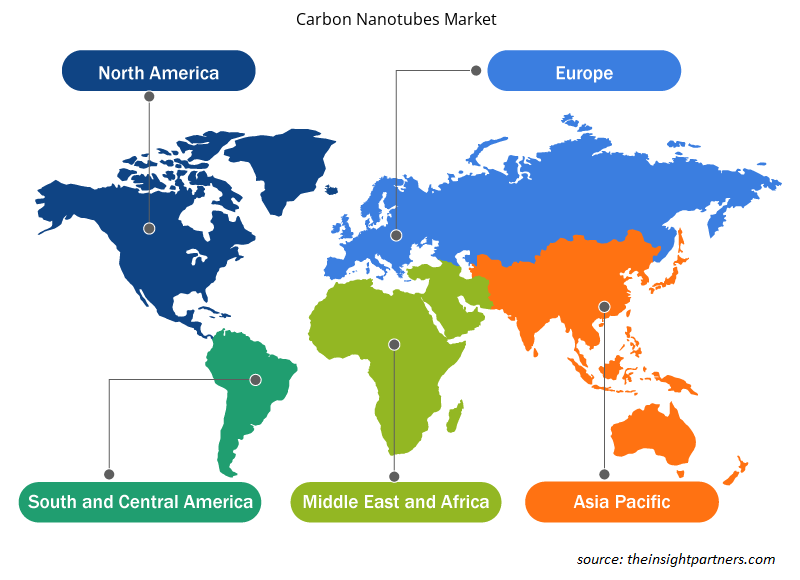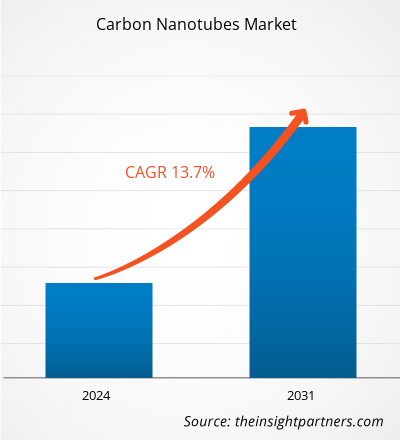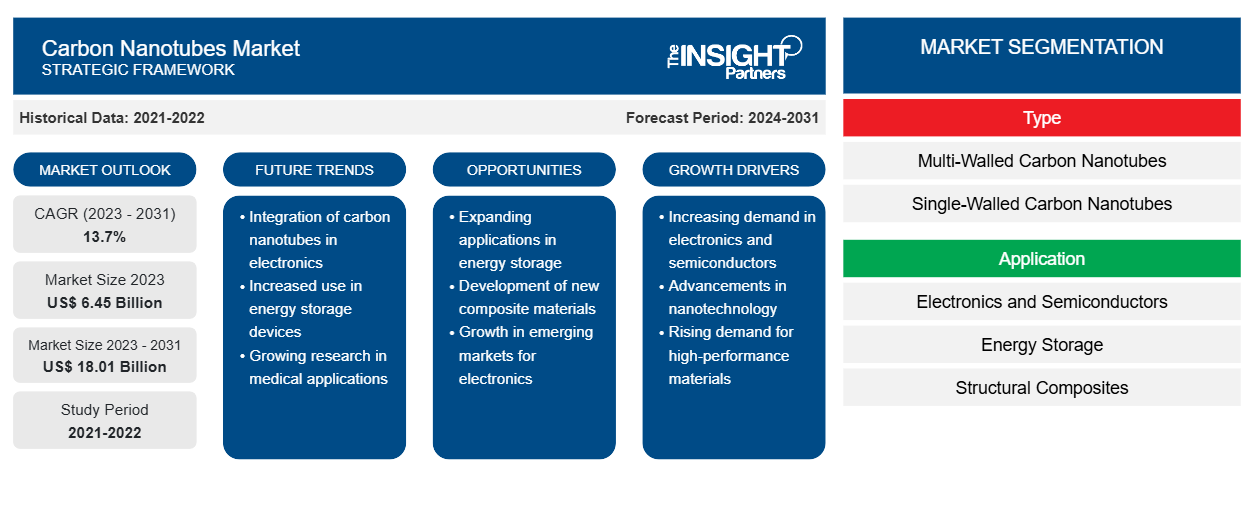Se proyecta que el tamaño del mercado de nanotubos de carbono alcance los 18.010 millones de dólares estadounidenses en 2031, frente a los 6.450 millones de dólares estadounidenses en 2023. Se espera que el mercado registre una CAGR del 13,7 % durante el período 2023-2031. La incorporación de CNT en tintas nanocompuestas para impresión 3D puede mejorar la funcionalidad del proceso de impresión avanzado y conferir propiedades disipativas electrostáticas.
Análisis del mercado de nanotubos de carbono
La creciente demanda de sustitutos ligeros de los metales con características térmicas, electroquímicas y mecánicas superiores ha dado lugar a un florecimiento de la investigación dirigida a la búsqueda de compuestos y materiales compuestos. Los avances tecnológicos y las aplicaciones a microescala de próxima generación en el sector eléctrico y electrónico necesitan materiales eficientes y de alta funcionalidad como los CNT. Además, la tecnología de compuestos basados en CNT se utiliza ampliamente en las industrias aeroespacial, de defensa, automotriz y de infraestructura. La Administración Nacional de Aeronáutica y del Espacio (NASA) financió un Instituto de Investigación de Tecnología Espacial (STRI) de cinco años llamado US-COMP, que comenzó en 2017, para la investigación y el desarrollo de compuestos basados en CNT. La investigación se centra en la innovación de material ligero de ultraalta resistencia para su aplicación en vehículos de exploración. Además, en 2020, Toray Industries Inc desarrolló un proceso de comunicación inalámbrica con un identificador de radiofrecuencia impreso utilizando compuestos semiconductores basados en CNT, parcialmente respaldado por el Ministerio de Medio Ambiente de Japón. El semiconductor compuesto CNT de la empresa ofrece una movilidad de 182 cm2/Vs, en comparación con los circuitos integrados y semiconductores impresos de bajo coste, que ofrecen una movilidad de 20 cm2/Vs.
Descripción general del mercado de nanotubos de carbono
Los nanotubos de carbono son estructuras cilíndricas extremadamente pequeñas hechas de átomos de carbono. Son conocidos por sus propiedades únicas, que incluyen alta resistencia a la tracción, estabilidad térmica y buena conductividad eléctrica. Los nanotubos de carbono de pared simple y los nanotubos de carbono de pared múltiple son dos tipos de nanotubos de carbono. Los nanotubos de carbono de pared simple están hechos de una sola capa de átomos de carbono enrollados en un tubo, mientras que los nanotubos de carbono de pared múltiple constan de varios tubos concéntricos. Los nanotubos de carbono se utilizan como materiales de refuerzo en materiales compuestos, materiales de detección en sensores, almacenamiento de energía en baterías, catalizadores en reacciones químicas y para aplicaciones biomédicas. En la industria médica, se utiliza para administración de fármacos, biosensores, imágenes e ingeniería de tejidos. En la industria electrónica , los nanotubos de carbono se emplean como transistores, interconexiones, sensores, pantallas, almacenamiento de energía, etc.
Personalice este informe según sus necesidades
Obtendrá personalización en cualquier informe, sin cargo, incluidas partes de este informe o análisis a nivel de país, paquete de datos de Excel, así como también grandes ofertas y descuentos para empresas emergentes y universidades.
-
Obtenga las principales tendencias clave del mercado de este informe.Esta muestra GRATUITA incluirá análisis de datos, desde tendencias del mercado hasta estimaciones y pronósticos.
Impulsores y oportunidades del mercado de nanotubos de carbonoNanotubes Market Drivers and Opportunities
Demanda creciente de nanotubos de carbono (CNT) para aplicaciones de almacenamiento de energíaNanotubes (CNTs) for Energy Storage Applications
Los nanotubos de carbono son nanoestructuras de carbono con propiedades electroquímicas y mecánicas características, como alta resistencia y rigidez, baja densidad, alta conductividad térmica y conductividad eléctrica. Las propiedades de los nanotubos de carbono se aprovechan para la investigación y el desarrollo de sistemas de almacenamiento de energía. Los nanotubos de carbono de pared simple y de pared múltiple se utilizan como aditivos conductores en baterías de iones de litio y para desarrollar electrodos de batería para mejorar el rendimiento de las baterías. La creciente demanda de sistemas de energía, junto con su creciente costo, ha influido en las organizaciones gubernamentales y los investigadores para desarrollar sistemas de energía eficientes para cumplir con los objetivos energéticos globales.nanotubes are carbon nanostructures with characteristic electrochemical and mechanical properties such as high strength and rigidity, low density, high heat conductivity, and electrical conductivity. The properties of CNTs are leveraged for the research and development of energy storage systems. Single-walled and multi-walled CNTs are utilized as conductive additives in Li-ion batteries and to develop battery electrodes to enhance battery performance. The rising demand for energy systems, along with its increasing cost, has influenced government organizations and researchers to develop efficient energy systems to fulfill global energy targets.
Adopción de nanotubos de carbono para el tratamiento del cáncerNanotubes for Cancer Treatment
Los recientes avances en la administración de fármacos y el tratamiento del cáncer implican el uso de nanotransportadores como los CNT, las nanocápsulas lipídicas sólidas, las nanopartículas magnéticas, las nanopartículas de oro y los liposomas. Las propiedades eléctricas, ópticas, químicas y mecánicas de los CNT se emplean en sistemas de administración de fármacos, imágenes biomédicas y tecnología antimicrobiana. Por lo tanto, la tecnología de administración de fármacos contra el cáncer basada en CNT está ganando popularidad, especialmente debido a su orientación selectiva y al control de la administración del fármaco. Los científicos han desarrollado una tecnología novedosa para introducir directamente el fármaco contra el cáncer, la doxorrubicina, a través de los CNT desde sacos esféricos de moléculas de fosfolípidos (liposomas) a través de la membrana plasmática celular. Un informe publicado por el Departamento de Energía de EE. UU. en 2022 reveló que los CNT fusionan los liposomas y las células cancerosas, iniciando la fusión de las membranas liposomales y las células cancerosas. Este proceso de fusión permite que el fármaco pase libremente del liposoma a la célula. Esto da como resultado la administración eficaz de la doxorrubicina, eliminando hasta el 90% de las células desordenadas. Por lo tanto, la adopción de CNT en el tratamiento del cáncer puede crear oportunidades lucrativas para el mercado de nanotubos de carbono durante el período de pronóstico.nanocarriers such as CNTs, solid lipid nanocapsules, magnetic nanoparticles, gold nanoparticles, and liposomes. The electrical, optical, chemical, and mechanical properties of CNTs are employed in drug delivery systems, biomedical imaging, and antimicrobial technology. Therefore, CNT-based anticancer drug delivery technology is gaining popularity, especially due to its selective targeting and controlling of drug delivery. Scientists have developed a novel technology to directly introduce the anticancer drug—doxorubicin—through CNTs from spherical sacs of phospholipid molecules (liposomes) via the cell plasma membrane. A report published by the US Department of Energy in 2022 revealed that CNTs merge liposomes and cancer cells, initiating the merger of liposomal membranes and cancer cells. This fusion process allows the drug to pass freely from the liposome to the cell. This results in the effective delivery of doxorubicin, eliminating up to 90% of disordered cells. Thus, the adoption of CNTs in cancer treatment can create lucrative opportunities for the carbon nanotubes market during the forecast period.
Análisis de segmentación del informe de mercado de nanotubos de carbono
Los segmentos clave que contribuyeron a la derivación del análisis del mercado de nanotubos de carbono son el tipo y la aplicación.
- Según el tipo, el mercado de nanotubos de carbono se divide en nanotubos de carbono de pared múltiple y nanotubos de carbono de pared simple. El segmento de nanotubos de carbono de pared múltiple tuvo una mayor participación de mercado en 2023.
- Por aplicación, el mercado está segmentado en electrónica y semiconductores, almacenamiento de energía, compuestos estructurales, aeroespacial y defensa, medicina y otros. El segmento de compuestos estructurales tuvo la mayor participación del mercado en 2023.
Análisis de la cuota de mercado de los nanotubos de carbono por geografía
El alcance geográfico del informe del mercado de nanotubos de carbono se divide principalmente en cinco regiones: América del Norte, Asia Pacífico, Europa, Medio Oriente y África, y América del Sur/América del Sur y Central.
La región de Asia Pacífico domina el mercado de nanotubos de carbono. El mercado de Asia Pacífico está segmentado en Australia, China, India, Japón, Corea del Sur y el resto de Asia Pacífico. Asia Pacífico se ha convertido en un mercado importante para los nanotubos de carbono debido a la creciente demanda de materiales de alto rendimiento en diversas industrias, como la aeroespacial, la automotriz, la electrónica y la energía. La región se ha convertido en un importante centro de producción de nanotubos de carbono, con varios fabricantes líderes que operan en países como China, Japón y Corea del Sur. Además, China es uno de los mayores mercados de nanotubos de carbono en Asia Pacífico, y el país informa de importantes inversiones en investigación y desarrollo y una creciente adopción de nanotubos de carbono en diversas aplicaciones. Varias empresas chinas, como Shenzhen Nanotech Port Co. Ltd., Chengdu Organic Chemicals Co. Ltd. y Suzhou NanoGrid Technology Co. Ltd., participan en la producción y comercialización de nanotubos de carbono.
Perspectivas regionales del mercado de nanotubos de carbono
Los analistas de Insight Partners explicaron en detalle las tendencias y los factores regionales que influyen en el mercado de nanotubos de carbono durante el período de pronóstico. Esta sección también analiza los segmentos y la geografía del mercado de nanotubos de carbono en América del Norte, Europa, Asia Pacífico, Oriente Medio y África, y América del Sur y Central.

- Obtenga datos regionales específicos para el mercado de nanotubos de carbono
Alcance del informe de mercado de nanotubos de carbono
| Atributo del informe | Detalles |
|---|---|
| Tamaño del mercado en 2023 | 6.450 millones de dólares estadounidenses |
| Tamaño del mercado en 2031 | US$ 18.01 mil millones |
| CAGR global (2023 - 2031) | 13,7% |
| Datos históricos | 2021-2022 |
| Período de pronóstico | 2024-2031 |
| Segmentos cubiertos |
Por tipo
|
| Regiones y países cubiertos |
América del norte
|
| Líderes del mercado y perfiles de empresas clave |
|
Densidad de actores del mercado de nanotubos de carbono: comprensión de su impacto en la dinámica empresarial
El mercado de nanotubos de carbono está creciendo rápidamente, impulsado por la creciente demanda de los usuarios finales debido a factores como la evolución de las preferencias de los consumidores, los avances tecnológicos y una mayor conciencia de los beneficios del producto. A medida que aumenta la demanda, las empresas amplían sus ofertas, innovan para satisfacer las necesidades de los consumidores y aprovechan las tendencias emergentes, lo que impulsa aún más el crecimiento del mercado.
La densidad de actores del mercado se refiere a la distribución de las empresas o firmas que operan dentro de un mercado o industria en particular. Indica cuántos competidores (actores del mercado) están presentes en un espacio de mercado determinado en relación con su tamaño o valor total de mercado.
Las principales empresas que operan en el mercado de nanotubos de carbono son:
- Nanoshel LLC
- NanoLab Inc
- Compañía Petroquímica Kumho Ltd.
- Industrias Klean Inc.
- LG Chem Ltd
Descargo de responsabilidad : Las empresas enumeradas anteriormente no están clasificadas en ningún orden particular.

- Obtenga una descripción general de los principales actores clave del mercado de nanotubos de carbono
Noticias y desarrollos recientes del mercado de nanotubos de carbono
El mercado de nanotubos de carbono se evalúa mediante la recopilación de datos cualitativos y cuantitativos posteriores a la investigación primaria y secundaria, que incluye publicaciones corporativas importantes, datos de asociaciones y bases de datos. A continuación, se incluye una lista de los avances en el mercado de los trastornos del habla y el lenguaje:
- En septiembre de 2020, Arkema se asoció con la Asociación Coreana de la Industria de Nanopartículas de Carbono. La asociación con la asociación ayudará a Arkema a mejorar su oferta de productos.
- En agosto de 2020, ChemSpec North America anunció un acuerdo de distribución no exclusiva con Nanocyl SA, con sede en Bélgica, para promover y distribuir diversos productos de nanotubos de carbono de paredes múltiples ("MWCNT") de Nanocyl en EE. UU. y Canadá.
- En agosto de 2022, LG Chem anunció la expansión de su inversión en nanotubos de carbono (CNT) con la construcción de la planta de fabricación de CNT de una sola línea más grande del mundo.
- En marzo de 2023, Canatu Oy (Vantaa, Finlandia), un desarrollador de nanomateriales de carbono, anunció una actualización en su fabricación de películas de nanotubos de carbono (CNT) para satisfacer la creciente demanda de productos de calefacción ADAS en la industria automotriz. Canatu afirmó que mejoró su línea de producción de películas de CNT de repetición y paso (SAR) agregando nueva capacidad de reactor y aumentando el nivel de automatización.
- En abril de 2020, OCSiAl anunció que puede comercializar hasta 100 toneladas anuales de sus nanotubos de carbono de pared simple TUBALL en Europa debido al expediente actualizado de la empresa según la legislación de la UE sobre “Registro, evaluación, autorización y restricción de sustancias y preparados químicos” (REACH), siendo además compatible con los nuevos Anexos sobre nanoformas.
Cobertura y resultados del informe sobre el mercado de nanotubos de carbono
El informe “Tamaño y pronóstico del mercado de nanotubos de carbono (2021-2031)” proporciona un análisis detallado del mercado que cubre las siguientes áreas:
- Tamaño del mercado y pronóstico a nivel global, regional y nacional para todos los segmentos clave del mercado cubiertos bajo el alcance
- Dinámica del mercado, como impulsores, restricciones y oportunidades clave
- Principales tendencias futuras
- Análisis detallado de las cinco fuerzas de Porter y PEST y FODA
- Análisis del mercado global y regional que cubre las tendencias clave del mercado, los principales actores, las regulaciones y los desarrollos recientes del mercado.
- Análisis del panorama de la industria y de la competencia que abarca la concentración del mercado, el análisis de mapas de calor, los actores destacados y los desarrollos recientes
- Perfiles detallados de empresas
- Análisis histórico (2 años), año base, pronóstico (7 años) con CAGR
- Análisis PEST y FODA
- Tamaño del mercado, valor/volumen: global, regional y nacional
- Industria y panorama competitivo
- Conjunto de datos de Excel
Informes recientes
Testimonios
Razón para comprar
- Toma de decisiones informada
- Comprensión de la dinámica del mercado
- Análisis competitivo
- Información sobre clientes
- Pronósticos del mercado
- Mitigación de riesgos
- Planificación estratégica
- Justificación de la inversión
- Identificación de mercados emergentes
- Mejora de las estrategias de marketing
- Impulso de la eficiencia operativa
- Alineación con las tendencias regulatorias























 Obtenga una muestra gratuita para - Mercado de nanotubos de carbono
Obtenga una muestra gratuita para - Mercado de nanotubos de carbono